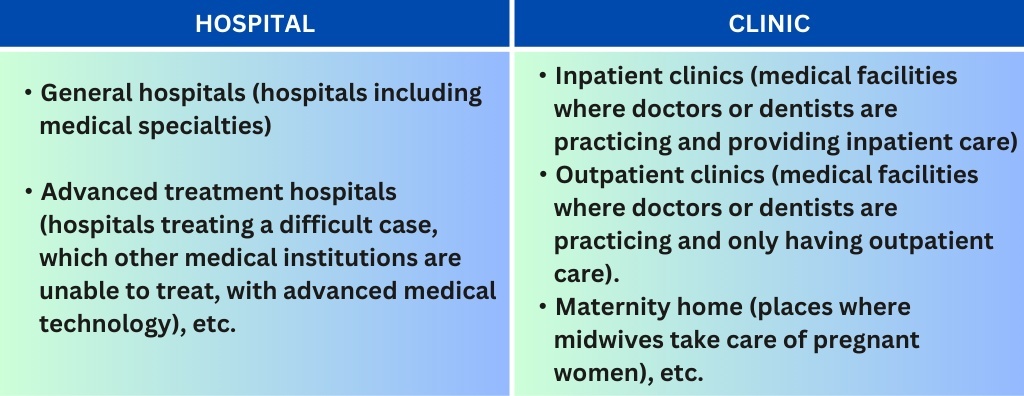2024 12/21
How Can Foreigners Find English-Speaking Hospitals in Tokyo?

Nobody ever knows what the future holds. Being ill and/or getting injured could happen to anyone. It is very important to know just in case, what you do if you need to see a doctor in Japan.
Japan has a unique healthcare system and not all hospitals respond in English. We will explain how to locate one, so foreigners can visit an English-speaking hospital in Tokyo.
How to Find an English-Speaking Hospital?
Before finding an English-speaking hospital, you may want to know the basic information about medical facilities in Japan such as:
◉ Types of medical institutions
◉ The different medical specialties
"Hospital" and "Clinic"
In Japan, "seeing a doctor" usually means having a medical examination at a "hospital" or "clinic".
A “hospital” is a medical institution with 20 or more beds, while a medical institution with 19 or fewer beds is called a "clinic".

Of these, people usually use general hospitals or clinics.
There is no GP (General Practice) in the Japanese medical system, and people visit any hospitals or clinics directly depending on their choice.
General hospitals have high-quality equipment for special treatment and hospitalization facilities to accept patients with serious conditions or needing hospitalization. It also accepts a patient with minor injuries. In this situation, patients with minor injuries should wait for their turn for more than 2 hours for a 10-minute treatment, for example.
Clinics tend to be smaller-sized facilities in comparison to general hospitals.
Privately owned by a doctor, it has a limited number of medical specialties and equipment to accept patients with mild symptoms. In many cases, people at a clinic do not wait as long as at a general hospital. Moreover, should a further examination or treatment be necessary, a doctor at a clinic will write a referral to a general hospital.
Hence it might be a good idea to visit a clinic if you have minor symptoms and a hospital for serious ones.
Different Types of Medical Specialities
In Japan, a patient sees a doctor in a particular medical specialty as follows:

Choose a medical institution that has the right medical specialty for your symptoms. If you are not sure which department you should visit, ask someone at the reception.
Ways of finding out about an English-speaking hospital
There are several ways to find an English-speaking hospital in Tokyo.
For example:
① Use Google (e.g. type in "English-speaking hospital near me").
② Ask for a referral from your travel insurance company.
③ Select a hospital accredited by a Japan Medical Service Accreditation for International Patients(JMIP).
Examples of JMIP hospitals:
・Tokyo Saiseikai Central Hospital
・Tokyo Metropolitan Hiroo Hospital
etc.
④ Check websites for medical facilities for foreigners:
・For Safe Travels in Japan: Guide for When You Are Feeling Ill
・Bureau of Public Health: Tokyo Metropolitan Government
・Tokyo Intercultural Portal Site
etc.
⑤ Refer to the Guidance Book(Tokyo)
This guidebook is published by Bureau of Social Welfare and Public Health:
・Download page(Bureau of Social Welfare and Public Health)

What Do You Need When Seeing a Doctor?
When going to a hospital, do not forget the following items.
✔ Passport or Residence Card
These kinds of documents are needed to prove identity.
You may be asked to show your passport or residence card at reception.
✔ National Health Insurance Card
If you stay in Japan for more than 3 months, you can join the National Health Insurance.
If you do not have it, you must pay the total amount of the medical bill.
✔ Travel Insurance Card
You will most likely need to join travel insurance before coming to Japan.
Normally, most travel insurance will cover the standard medical bills. However, to ensure this is true you will have to check with their policies.
✔ Dispensatory
If you are taking any medication, you should take a dispensatory with you.
✔ Cash
Most hospitals and clinics accept cash only.
You may also need coins to take public transport.
Therefore, you will need to carry a suitable amount of cash, between 5000-10,000 yen, with you at all times.

5 Steps to Visit a Hospital
When you visit a hospital with or without an appointment for the first time, you are normally categorized as an “outpatient”.
The main steps for an outpatient when visiting the hospital are as follows:
・Step 1: Sign in at the reception
・Step 2: Consultation
・Step 3: Treatment
・Step 4: Pay bills
・Step 5: Get a prescription
Step 1: Sign in at the Reception
An outpatient should check in during reception hours.
There are different times in different medical institutions, yet outpatient reception hours are normally divided into morning and afternoon (e.g. between 8 am-11 am and 1 pm-3 pm) on weekdays. On weekends and national holidays, they are closed.
When you visit the hospital, you go to the main reception first.
Then fill in your name and other necessary information on a medical application form.
Hand in the form with documents (passport, National Health Insurance card, etc.) at the reception.
Go to the specific department that the receptionist has guided you to. This will entail a waiting room, where you will be seated until called by a professional for a consultation.
In a small-seized clinic, there is only one waiting room. Take a seat at the main reception after checking in and wait for your turn.
Step 2: Consultation
In the consultation room, the doctor will give you a medical interview.
Step 3: Treatment
Treatment is carried out as necessary, such as supplying medication.
Step 4: Pay Bills
When the treatment is finished, return to the main reception, and pay the bill for the treatment.
Step 5: Get a Prescription
Once the prescription has been issued, you can obtain the medicine at the pharmacy attached to the hospital or near the building.

6 Steps of Hospitalization
If you need to be hospitalized, the process differs from normal medical treatment.
The main steps during hospitalization are as follows:
① Find a Guarantor
When a foreigner is hospitalized, a guarantor is required.
For this, you could ask a relative, a schoolteacher, or a work supervisor. If there is no one you can ask, consult the hospital.
② Prepare for Hospitalization
You need items for the procedure of hospitalization and items for staying at the hospital.

Normally using mobile phones during hospitalization is not allowed just in case, as medical equipment can be affected via electronic use. Phones can be used only in mobile-free areas. Other than that, you may only use a public phone.
③ Proceeding Hospitalization
The hospitalization procedure will occur at the reception.
At this point, you will be available for a shared room or a private room. However, if you are admitted to a private room, you will be charged more than a shared room. This difference is not covered by insurance, so you have to pay the full amount yourself.
④ Staying in the Hospital
While in the hospital, you will live according to a timetable set by the hospital.
An Example:
・6:00 Wake-up time
・8:00 Breakfast
・12:00 Lunch
・18:00 Dinner
・20:00 End of visiting hours (till 7 am)
・22:00 Lights out
◉ Nursing care
Mainly a nurse takes the lead in planning and caring for a patient’s hospital stay. Consult with the nurse about anything from admission to discharge.
◉ Medications
You should take the medication ordered by your doctor at the prescribed time.
If you wish to take any medication other than those prescribed by the hospital, consult your doctor or nurse.
◉ Chaperone
Generally, an escort is not required, but in special circumstances, the doctor may permit a family member to accompany the patient. Consult the ward nurse manager if you wish to be accompanied by a chaperone, as notification is required.
⑤ Discharge
Once you have received permission from your doctor, you will choose a discharge date (normally only available in the morning) with your doctor. On the day of discharge, the staff will prepare the procedure.
⑥ Pay Medical Bill
On the day you are discharged from the hospital, you will be asked to pay hospitalization fees. The person in charge of medical affairs may bring the bill to your room. If you wish, you will be informed of the estimated amount of your hospitalization costs the day before.
If you are unable to pay on the day of discharge for any reason, consult the ward manager or the accounting counter in advance.

Call an Ambulance in a Case of an Emergency
If you need immediate care in cases such as a traffic accident, stroke, anaphylactic shock, and so on, call an ambulance.
※ An emergency call in Japan is “119”.
You need to tell an operator:
✔ The medical emergency
✔ Your location
✔ Your name, age, and contact details
✔ Your symptom(s)/situation
If it is difficult to call yourself, ask someone nearby.
In most cases, you will be taken to the ER (Emergency Room) and be provided with medical treatment till your condition becomes stable.
The portal site published by the Fire and Disaster Management Agency of the Ministry of Internal Affairs and Communications is helpful for further information about emergencies.
If you are not sure whether you should call an emergency or not, ring #7119 (Tokyo Fire Department).
The ER is also available out of hours. If you need medical treatment at the weekend or late at night, contact the emergency outpatient department for instructions.
The following websites are useful for finding out which hospitals in Tokyo have an emergency outpatient department:
・Information on emergency hospitals (Tokyo Fire Department)

Conclusion
We explained how to visit an English-speaking hospital in Tokyo.
Depending on the situation, you should use medical facilities the following:
◉ Mild symptoms: a clinic or hospital
◉ If there is a threat of surgery or serious illness: a hospital
◉ In case of emergency or after-hours: an emergency room
If you get sick or have an accident in a foreign country, you may feel very anxious.
It is a good idea to find out what kind of medical facilities are available in your area and decide which hospital to use when you become ill.
Reference Links:
https://www.jpss.jp/ja/life/crisis/15/
https://www.jpss.jp/ja/life/crisis/14/
https://matcha-jp.com/jp/9910
https://www.jnto.go.jp/emergency/jpn/mi_guide.html
https://www.tfd.metro.tokyo.lg.jp/index.html